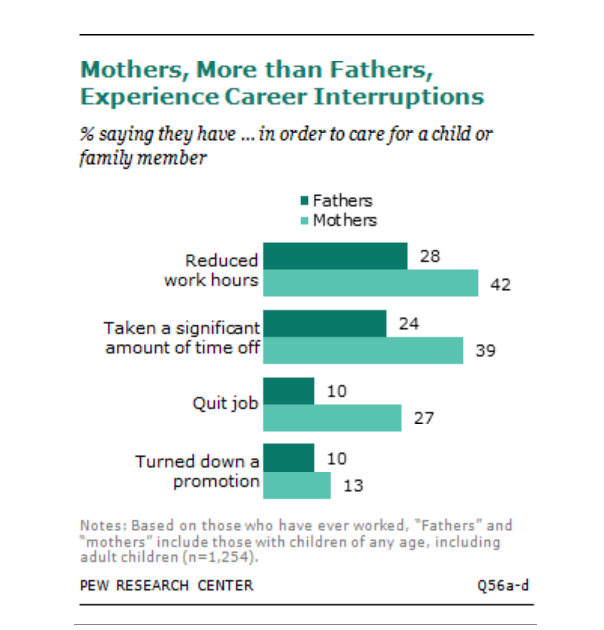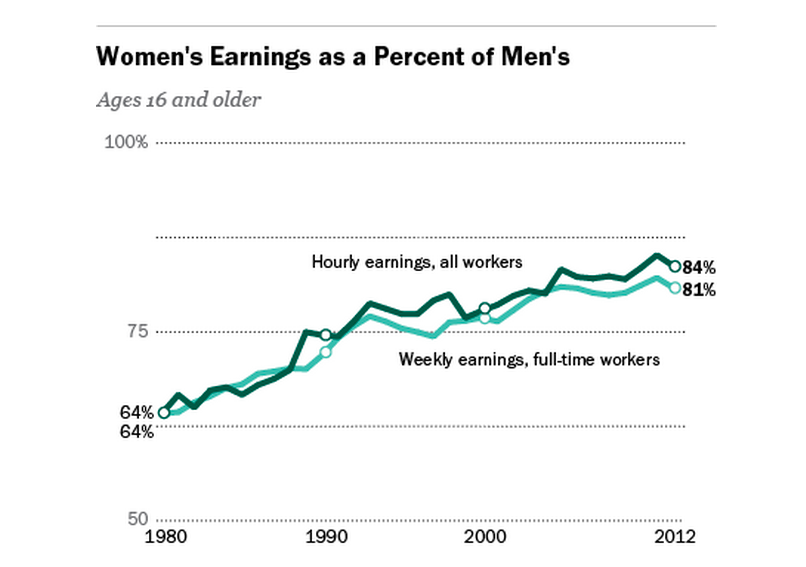By COLLIN KRIZMANICH
Capital News Service
LANSING — More than 50 years after Congress first acted to address the gender wage gap, many women across the country are still earning less than their male coworkers. Democrats in Michigan recently introduced a 12-bill package aimed at eliminating this disparity.
Michigan ranked tenth worst in the nation when it comes to the gender pay gap, according to the American Association of University Women. Understanding how and why this gap exists is critical in addressing the issue.

Career choice interruptions between men and women Source: Pew Research Center
What is the gender wage gap?
Simply put, the gender wage gap is the difference, on average, between how much money men make and how much money women make. Many people, including President Obama, often bring up the statistic that, based on median earnings, women earn 77 cents for every dollar a man earns.
This number is frequently used by politicians and advocates when explaining the need to end wage discrimination in the workplace. However, workplace discrimination does not take into account many other factors that could be leading to the wage gap. For instance, a Pew poll released in 2012 found that excluding part-time workers, who are more likely to be women, reduced this number to 84 cents on the dollar.
Why is it difficult to gauge the cause of the gender wage gap?
While the “77 cents on the dollar” statistic can be appealing in its simplicity, some consider it misleading. It does not say women earn 77 cents on the dollar for working the same job, but across all jobs.
“In general, the more simple the statistic, the less meaningful it is,” said Jean Kimmel, professor of economics at Western Michigan University. “The more meaningful numbers that you should talk about are probably more complicated.”
The idea that discriminatory pay practices by employers is the sole cause of this gap in median earnings is too simple, agreed Jennifer Ward-Batts, professor of economics at Wayne State University. A more thorough analysis suggests that while there is a wage gap between men and women who work the same job, it’s not nearly as large.

History of gender wage gap Source: Pew Research Center
“When you do more sophisticated statistics, you will typically find women earn 5-10 percent less than men, even when you hold constant your occupation, major, grades and other factors,” Kimmel said.
Here is a closer look at some of the factors driving the gender wage gap:
Discriminatory actions by employers
Discriminatory practices by employers have historically been a major factor in the wage gap. Congress first acted to address this discrimination by passing the Equal Pay Act of 1963, which required businesses to pay equal wages for equal work. This legislation was the catalyst that has led to the pay gap being nearly halved since its passage, according to Charles Ballard, professor of economics at Michigan State University.
The first piece of major legislation signed into law by President Obama was the Lilly Ledbetter Fair Pay Act, which Ballard considers “one of the most important things in recent American history.” This legislation increased the opportunity for women to sue their employers if they found men in the same position were being paid more.
“It’s very hard nowadays to find anybody who is openly in favor of overt labor market discrimination,” Ballard said. “We do have anti-discrimination laws on the books, and enforcing those laws is important.”
Democrats in the Michigan legislature recently introduced legislation that aims at expanding current anti-discrimination laws in the state.
But simply enforcing those laws is not going to solve the gender wage gap. While women have the opportunity to sue employers for wage discrimination, it’s not easy.
In order to sue your employer, you need evidence of discrimination.This means that you must know how much your employer is paying your fellow employees. Currently, employers do not have to make this information public.
Some economists suggest that requiring publicly traded businesses to disclose this information would give women the evidence needed to bring their case before a court. Legislation was recently introduced by Democrats in the Michigan House of Representatives that would make this information more accessible.
Career choice
Another factor in the wage gap, which many advocates consider a result of systemic discrimination that discouraged women from entering certain fields, is differences in career choice between men and women. Economists call this occupational segregation.
“Nowadays a lot of women are going into legal, accounting, doctors — so occupational segregation is still alive and well but nearly as severe as it used to be,” Ballard said. This decrease in occupational segregation has contributed to the shrinking wage gap over the years.
“But there are a lot of high paid occupations where there is still segregation, a lot of those include STEM — science, technology, engineering and mathematics — disciplines.”
One way to shrink the gap is by encouraging young women to join some of these higher paying career paths, particularly those in science, math, technology and engineering, according to Ballard.
Part-time and seasonal workers
Other factors include the number of hours worked — women are more likely to work part-time or seasonal jobs. Ballard suggested that raising the minimum wage would have a direct impact on closing the wage gap.
Competition in the workplace often creates an unequal playing field for women who have children at home, as women often experience interruption in their careers due to child care.
“Women are competing in the labor market against men, a lot of whom have wives that work part time or stay at home,” Ward-Batts said. “So those men are able to focus much more on their career; therefore we can expect them to have higher earnings in the long run.”
Some other countries have taken measures to confront this issue. In particular, some Scandinavian countries have a wage gap that is half what it is in the United States, according to the Organization for Economic Cooperation and Development.
“They have a very generous parental leave policy, they push men to take at least some of that leave,” Ward-Batts said. “Research has found if the man takes a month off, down the road he ends up spending a lot more time on child care.”
As men are more active in the child care process, it creates more opportunity for women to focus on their career, resulting in advancement in the workplace as well as higher wages.